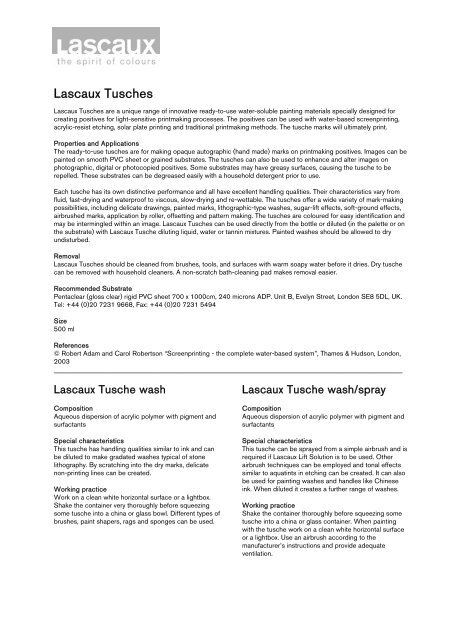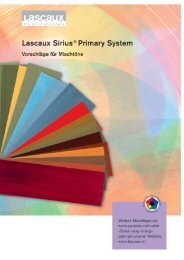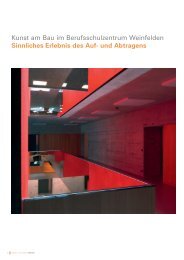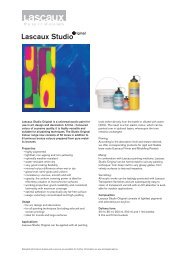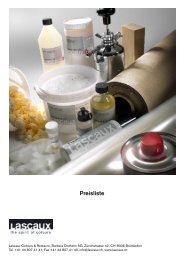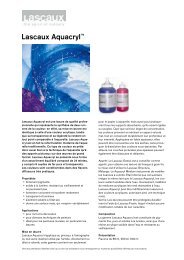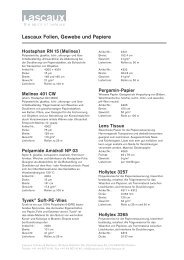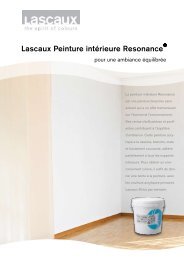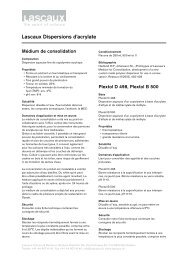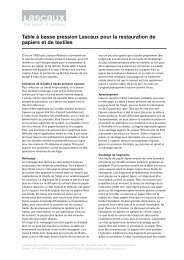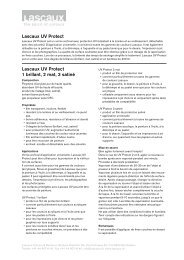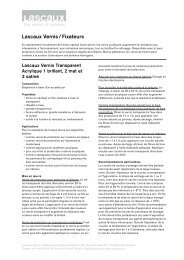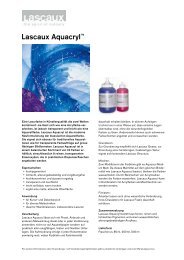Lascaux Tusches - Lascaux Colours & Restauro
Lascaux Tusches - Lascaux Colours & Restauro
Lascaux Tusches - Lascaux Colours & Restauro
Create successful ePaper yourself
Turn your PDF publications into a flip-book with our unique Google optimized e-Paper software.
<strong>Lascaux</strong> <strong>Tusches</strong><br />
<strong>Lascaux</strong> <strong>Tusches</strong> are a unique range of innovative ready-to-use water-soluble painting materials specially designed for<br />
creating positives for light-sensitive printmaking processes. The positives can be used with water-based screenprinting,<br />
acrylic-resist etching, solar plate printing and traditional printmaking methods. The tusche marks will ultimately print.<br />
Properties and Applications<br />
The ready-to-use tusches are for making opaque autographic (hand made) marks on printmaking positives. Images can be<br />
painted on smooth PVC sheet or grained substrates. The tusches can also be used to enhance and alter images on<br />
photographic, digital or photocopied positives. Some substrates may have greasy surfaces, causing the tusche to be<br />
repelled. These substrates can be degreased easily with a household detergent prior to use.<br />
Each tusche has its own distinctive performance and all have excellent handling qualities. Their characteristics vary from<br />
fluid, fast-drying and waterproof to viscous, slow-drying and re-wettable. The tusches offer a wide variety of mark-making<br />
possibilities, including delicate drawings, painted marks, lithographic-type washes, sugar-lift effects, soft-ground effects,<br />
airbrushed marks, application by roller, offsetting and pattern making. The tusches are coloured for easy identification and<br />
may be intermingled within an image. <strong>Lascaux</strong> <strong>Tusches</strong> can be used directly from the bottle or diluted (in the palette or on<br />
the substrate) with <strong>Lascaux</strong> Tusche diluting liquid, water or tannin mixtures. Painted washes should be allowed to dry<br />
undisturbed.<br />
Removal<br />
<strong>Lascaux</strong> <strong>Tusches</strong> should be cleaned from brushes, tools, and surfaces with warm soapy water before it dries. Dry tusche<br />
can be removed with household cleaners. A non-scratch bath-cleaning pad makes removal easier.<br />
Recommended Substrate<br />
Pentaclear (gloss clear) rigid PVC sheet 700 x 1000cm, 240 microns ADP. Unit B, Evelyn Street, London SE8 5DL, UK.<br />
Tel: +44 (0)20 7231 9668, Fax: +44 (0)20 7231 5494<br />
Size<br />
500 ml<br />
References<br />
© Robert Adam and Carol Robertson “Screenprinting - the complete water-based system”, Thames & Hudson, London,<br />
2003<br />
______________________________________________________________________________________________________<br />
<strong>Lascaux</strong> Tusche wash<br />
Composition<br />
Aqueous dispersion of acrylic polymer with pigment and<br />
surfactants<br />
Special characteristics<br />
This tusche has handling qualities similar to ink and can<br />
be diluted to make gradated washes typical of stone<br />
lithography. By scratching into the dry marks, delicate<br />
non-printing lines can be created.<br />
Working practice<br />
Work on a clean white horizontal surface or a lightbox.<br />
Shake the container very thoroughly before squeezing<br />
some tusche into a china or glass bowl. Different types of<br />
brushes, paint shapers, rags and sponges can be used.<br />
<strong>Lascaux</strong> Tusche wash/spray<br />
Composition<br />
Aqueous dispersion of acrylic polymer with pigment and<br />
surfactants<br />
Special characteristics<br />
This tusche can be sprayed from a simple airbrush and is<br />
required if <strong>Lascaux</strong> Lift Solution is to be used. Other<br />
airbrush techniques can be employed and tonal effects<br />
similar to aquatints in etching can be created. It can also<br />
be used for painting washes and handles like Chinese<br />
ink. When diluted it creates a further range of washes.<br />
Working practice<br />
Shake the container thoroughly before squeezing some<br />
tusche into a china or glass container. When painting<br />
with the tusche work on a clean white horizontal surface<br />
or a lightbox. Use an airbrush according to the<br />
manufacturer’s instructions and provide adequate<br />
ventilation.
Airbrush techniques<br />
A simple airbrush can be used to apply the undiluted<br />
tusche in even layers over the <strong>Lascaux</strong> Lift Solution<br />
image until it is covered. Alternatively the airbrush can be<br />
used as a drawing instrument. The airbrushed dots<br />
resemble aquatints or tonal effects. Stencils can be used<br />
to build up an image. The sprayed areas will ultimately<br />
print. The airbrush should be rinsed thoroughly with water<br />
after use.<br />
<strong>Lascaux</strong> Tusche waterproof<br />
Composition<br />
Aqueous dispersion of acrylic polymer with pigment<br />
Special characteristics<br />
Fast drying, waterproof and scuff resistant, this semiviscous<br />
tusche has homogenous covering power and is<br />
useful for a broad range of painted marks. The diluted<br />
tusche dries to resemble ‘toad-skin’ washes usually<br />
found in zinc-plate lithography.<br />
Working practice<br />
Work on a clean white horizontal surface or a lightbox.<br />
Use a china or glass bowl as a palette. Brushes, paint<br />
shapers, and rags can be used to make marks. The<br />
marks will dry quickly and will not bleed when layers of<br />
other tusches are painted on top. The painted areas will<br />
ultimately print. Brushes and tools should be cleaned<br />
before the tusche dries on them.<br />
<strong>Lascaux</strong> Tusche water-soluble<br />
Composition<br />
Aqueous dispersion of vinyl acetate copolymer with<br />
pigment<br />
Special characteristics<br />
This viscous tusche can be painted in a smooth even<br />
layer which can be scratched away to create delicate<br />
non-printing lines. It can also be used for a broad range<br />
of painted marks, offsetting and pattern-making. The<br />
diluted tusche dries to create characterful granular<br />
washes. Dry marks can be re-wet and altered if required.<br />
Working practice<br />
Work on a clean white horizontal surface or a lightbox.<br />
Use a china or glass bowl as a palette. Brushes, paint<br />
shapers, rags and sponges can be used to make marks.<br />
Patterns can be created by offsetting materials such as<br />
painted card stencils, linocuts, printing blocks, embossed<br />
paper, leaves or feathers. Blotting paper can be used to<br />
apply or lift off the tusche. The Tusche can be used<br />
directly from the bottle or diluted. The painted areas will<br />
ultimately print.<br />
Drawing techniques<br />
Smooth PVC sheet and a watercolour wash brush are<br />
required for these techniques. One method is to draw<br />
into a flat painted layer of <strong>Lascaux</strong> Tusche water-soluble<br />
while it is still wet. Paint shapers, the ends of brushes or<br />
cotton buds can be used to generate lines of different<br />
types. Another method is to paint a thin and even layer of<br />
tusche on a sheet of smooth transparent PVC sheet.<br />
When this is completely dry a drawing can be made<br />
using etching tools or other materials, such as wire wool.<br />
The delicate lines created will be non-printing.<br />
<strong>Lascaux</strong> Tusche soft-ground<br />
effect<br />
Composition<br />
Aqueous dispersion of polyvinyl alcohol with pigment<br />
Special characteristics<br />
This slow drying viscous tusche has been designed to<br />
produce effects similar to soft ground in traditional<br />
etching. Using this method soft non-printing drawings<br />
may be made and impressions of fabric, leaves, feathers<br />
and other collage materials may be taken. The tusche can<br />
also be used for a broad range of painted marks and can<br />
be drawn into with paint shapers and other tools. The<br />
diluted tusche dries to create granular washes. Dry marks<br />
can be re-wet and altered.<br />
Working practice<br />
Work on a clean white horizontal surface or a lightbox.<br />
Use a glass slab to roll out the tusche or if painting use a<br />
china or glass bowl as a palette. A soft polyvinyl hand<br />
roller is ideal. A warm fan or warm printmaking drying<br />
cabinet will speed up the drying time.<br />
Making collage-based images<br />
Cut two sheets of smooth PVC sheet to a slightly larger<br />
size than the image. Check that the sheets fit the etching<br />
press bed and can be covered by the blankets. Then,<br />
working on a clean work surface masking-tape the<br />
corners of one sheet down and roll the tusche out thinly<br />
to form a smooth flat area in the centre of the sheet.<br />
Impressions can be taken immediately or for up to 90<br />
minutes after rolling out the tusche. The results will be<br />
different depending on how dry the tusche is. Position<br />
the prepared sheet on the press bed and arrange a<br />
collage of low-profile textured materials such as feathers,<br />
leaves, threads and paper shapes on top of the tusche.<br />
Avoid wire, chain links or other hard objects that will<br />
cause damage to the blankets or press. The second<br />
sheet of thin transparent smooth PVC is laid on top of<br />
the collage, followed by some clean sheets of tissue and<br />
the blankets of the etching press.<br />
The two sheets and the collage are rolled through the<br />
etching press. The image will vary depending on the<br />
pressure, which can be decreased by removing a blanket.
After passing through the press the blankets, tissue and<br />
the top PVC sheet are lifted away. An image will have<br />
offset onto this sheet and this may be used as a positive<br />
if desired. The collage will be embedded in the tusche<br />
that was rolled on the first PVC sheet. An etching needle<br />
is useful to peel each item carefully from the tusche<br />
without creating unwanted marks. This lower PVC sheet<br />
can then be used as a positive when the tusche is fully<br />
dry.<br />
A simple alternative to this process is to paint a thin layer<br />
of tusche on one sheet, arrange the collage, lay another<br />
sheet over the collage and take an impression by rubbing<br />
the top sheet by hand.<br />
Creating non-printing drawings<br />
Secure a transparent smooth PVC sheet on which a<br />
tusche layer has been rolled-out to a clean drawing<br />
board by attaching the PVC sheet's corners with<br />
masking-tape.<br />
Cut a piece of tissue paper larger than the PVC sheet<br />
and lay it over the tusche, overlapping all edges. Tape the<br />
tissue to the board at each corner. Then lay a piece of<br />
drawing paper overlapping the tissue, securing it in the<br />
same way. When you draw on the drawing paper (within<br />
the boundaries of the tusche) the pressure of the pencil<br />
or crayon on the paper causes the tissue to absorb the<br />
tusche, leaving the PVC sheet clear in those areas.<br />
When the image is complete remove the drawing paper<br />
and carefully peel off the tissue. Drawings made with this<br />
method have a soft appearance and drawing papers with<br />
different textures will create different effects.<br />
Exposing the positive<br />
The tusche image may appear faint on the substrate but<br />
will usually expose successfully as the particles are<br />
opaque. If necessary, opacity may be increased by<br />
dusting the nearly dry tusche image with talcum powder.<br />
______________________________________________________________________________________________________<br />
<strong>Lascaux</strong> Lift Solution<br />
Composition<br />
Calcium carbonate in water<br />
Special characteristics<br />
<strong>Lascaux</strong> Lift Solution is used in conjunction with <strong>Lascaux</strong><br />
Aquatint resist (see <strong>Lascaux</strong> Aquatint resist technical<br />
sheet – available fall 2004) or <strong>Lascaux</strong> Tusche<br />
wash/spray. Lift techniques are liberating to work with as<br />
the painted marks take on a particular characteristic<br />
when they are processed. The method is similar to<br />
‘sugar-lift’ in traditional etching, and the marks made with<br />
<strong>Lascaux</strong> Lift Solution resemble classic sugar-lift marks.<br />
When the <strong>Lascaux</strong> Lift Solution is used to make an<br />
autographic positive, the painted marks will be nonprinting<br />
and the sprayed Tusche background will print.<br />
Working practice<br />
Work close to the airbrush-spraying unit on a clean white<br />
horizontal surface or a lightbox. Shake the container<br />
thoroughly before use. Smooth transparent PVC sheet<br />
should be used.<br />
Painting an image<br />
A bold linear image is ideal for this medium and a range<br />
of brushes can be used. The painting will dry fairly rapidly<br />
and becomes chalky-looking and fragile. Unwanted areas<br />
should be lifted cleanly away.<br />
Processing the image<br />
When the image is complete an airbrush is used to cover<br />
the image with fine even layers of <strong>Lascaux</strong> Tusche<br />
wash/spray. Spraying the <strong>Lascaux</strong> Lift Solution image<br />
prevents any smudging of the fragile painting. The pattern<br />
of dots sprayed will create a tone on PVC. The artist can<br />
choose to stop layering at any point. Each layer should<br />
be allowed to dry briefly before the application of the next<br />
and in this way a continuous impermeable layer can be<br />
formed.<br />
Autographic positive method<br />
Once the airbrushed <strong>Lascaux</strong> Tusche wash/spray is<br />
completely dry on the PVC sheet the <strong>Lascaux</strong> Lift<br />
Solution can be gently rubbed away with soft dry tissues<br />
or a soft cloth. The tusche will remain in place and the<br />
powdery deposit can be disposed of. Some powder may<br />
adhere to the sprayed tusche increasing its opacity.<br />
These areas of tusche will ultimately print.<br />
Removal<br />
<strong>Lascaux</strong> Lift Solution can be cleaned from brushes, tools,<br />
bowls and surfaces with warm soapy water.<br />
Size<br />
500 ml<br />
<strong>Lascaux</strong> Tusche diluting liquid<br />
Composition<br />
Aqueous solution of surfactants<br />
Special characteristics<br />
A ready-to-use liquid for diluting <strong>Lascaux</strong> <strong>Tusches</strong> to alter<br />
their handling characteristics or to create delicate<br />
washes on positives.<br />
Working practice<br />
Work on a clean white horizontal surface or a lightbox.<br />
Use a china or glass bowl as a palette.<br />
Painting techniques<br />
Delicate washes can be created by adding <strong>Lascaux</strong><br />
Tusche diluting liquid to the tusche in the palette or on
the substrate. Depending on the quantity added, the<br />
painted marks will be altered or will reticulate as it dries.<br />
Tannin and other <strong>Lascaux</strong> tusches can be added to<br />
create a further range of wash effects.<br />
Removal<br />
<strong>Lascaux</strong> Tusche diluting liquid can be cleaned from<br />
brushes with warm soapy water.<br />
Size<br />
500 ml<br />
_____________________________________________________________________________<br />
Disclaimer:<br />
The information provided above is given to the best of our knowledge and is based on our current research and experience. It does not absolve the artist<br />
from the responsibility of first testing the suitability of our products for the substrate and specific use conditions he or she has in mind. This technical sheet<br />
will become invalid with any revised edition. The latest update is always found on our website.<br />
52321.02 – 04


